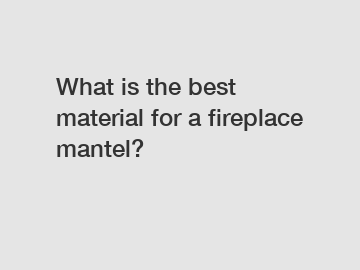What is the best material for a fireplace mantel?
What is the best material for a fireplace mantel?
Fireplace mantels not only enhance the visual appeal of your fireplace but also serve as a focal point in your living space. Choosing the right material for a fireplace mantel is essential to ensure its durability, functionality, and overall aesthetic appeal. With numerous options available, it can be overwhelming to decide which material is the best fit for your fireplace mantel. In this article, we will explore different materials commonly used for fireplace mantels and discuss their pros and cons.
1. Wood:

Wood is a classic and timeless choice for fireplace mantels. It offers versatility in terms of design, with various wood types and finishes available. Wood mantels can be crafted to match any interior style, from traditional to contemporary. However, the durability of wood mantels depends on the quality of the wood used. Hardwoods like oak, maple, or cherry are more resilient than softwoods. Additionally, wood mantels require regular maintenance to ensure they stay in good condition.
2. Stone:
If you are looking for a more rustic or natural look, stone fireplace mantels are a great option. Stone mantels can be made from materials such as limestone, marble, granite, or even faux stone. They add a touch of elegance and durability to your fireplace. Stone mantels are known for their resilience and ability to withstand heat, making them suitable for both wood-burning and gas fireplaces. However, they can be heavy and may require professional installation. Regular cleaning and sealing are necessary to maintain the stone's appearance.
3. Cast Stone:
Cast stone mantels offer the look of natural stone at a relatively lower cost. This composite material is made by mixing crushed stone, cement, and other additives. Cast stone mantels can mimic the appearance of various natural stones, giving you plenty of design options. They are lighter than natural stone mantels and can be easily installed without the need for additional support. However, like stone mantels, cast stone mantels should be sealed and periodically cleaned to preserve their appearance.
4. Metal:
For a modern and sleek look, metal fireplace mantels are worth considering. Steel, wrought iron, and brass are commonly used to create metal mantels. Metal mantels offer a contemporary touch and can be customized to fit your desired design. They are highly durable and resistant to heat. However, metal mantels can be difficult to install and may require professional assistance. While they are low-maintenance, some metals may rust over time, so proper care is necessary.
In conclusion, the best material for a fireplace mantel depends on your personal style, budget, and desired level of maintenance. Wood mantels offer a classic and versatile option, but they require regular care. Stone mantels provide a natural and elegant look while being highly durable, but they can be heavy and expensive. Cast stone mantels offer a cost-effective alternative to natural stone, but they still require maintenance. Metal mantels give a modern touch to your fireplace and are relatively low-maintenance, although installation may be more complex. Consider these factors and choose the material for your fireplace mantel that best suits your needs, style, and preferences.
For more book style headstones european, cherub marble sculpture with tombstone, marble benches for cemeteryinformation, please contact us. We will provide professional answers.
243
0
0

Comments
All Comments (0)